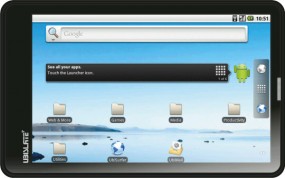But the scope of some big decisions made by international government agencies – and the price of non-U.S. devices – could upset the apple cart.
Consider India. Last fall saw the launch of the highly touted US$50 Aakash Android tablet for education (subsidized to US$35). That initiative subsequently stumbled following reports the first models built by the UK firm DataWind were sluggish and fragile. The government has since decided to press ahead with a new version with improved specifications.
Yet the overwhelming interest in what was supposed to be a first run of 100,000 tablets has spurred the growth of a handful of new education-focused competitors. They’ve developed tablets that are more expensive, but apparently more capable: the US$100 ATab, US$150 HCL MeTab, and, perhaps most interesting, the US$125 Funbook – interesting in that manufacturer Micromax’s education content partner for the Funbook is the international educational publishing giant Pearson. All of these relatively inexpensive devices run on Android.
Another international initiative of note: One Laptop Per Child’s XO-3, a projected $100 tablet, due this year, with prototypes shown at January’s Consumer Electronics Show. Designed for students in developing countries, it has OLPC’s now-signature hand crank (for when regular power isn’t available) and it, too, runs on Android (or OLPC’s own Sugar OS).
INTERNATIONAL GROWTH
No matter how cheap, having hardware isn’t enough if there isn’t a market. Yet as rapidly as U.S. education appears to be moving toward tablets in a decentralized manner, in pockets here and there, other countries’ education officials are embracing them in bulk.
Thailand’s Ministry of Education has announced plans to provide tablets for all of its first-grade students – 900,000 of them. As part of its Digital Education Revolution program, Australia has provided every 9th-through-12th grade student with either a laptop or a tablet this year – and due to purchases of lower-cost tablets, the number of devices actually outnumber students.
And though doubts have been expressed about providing tablets for the youngest grades, South Korea is still moving ahead with plans to replace K-12 textbooks with tablets starting in 2014.
Regardless of where in the world they're deployed, tablets present key issues that must be dealt with: Settling on appropriate educational content for a full curriculum, whether to attach a keyboard, and the ideal tablet screen size. While many inexpensive tablets are 7 inches, more expensive models such as the iPad are 10 inches – and that’s the minimum size required, for example, for using tablets for the forthcoming Common Core assessments. Plus, of course, there are the traditional concerns that apply to any technology in education, such as teacher training, using the tech effectively for learning, and cost.
Considering the speed of tech adoption and growth in the past few years, it's clear that tablets will pervade the education landscape. But it's too early to foretell which devices, or even operating systems, will last or turn out to be fads.
Frank Catalano is a consultant, author and veteran analyst of digital education and consumer technologies. He tweets @FrankCatalano, consults as Intrinsic Strategy, and writes the regular Practical Nerd column for GeekWire.



